六年级英语阅读理解应试技巧+专项训练练习题(含答案解析)
六年级英语阅读理解题型过关技巧指导+专项训练练习题(含答案解析)

六年级英语阅读理解题型过关技巧指导一、培养正确的阅读习惯有许多孩子在长期的学习中往往形成了各种阅读习惯,如一个词一个词地读,且常伴有一些习惯动作:用手指、摆头等,这就是速读的障碍,并且可能影响到孩子一生的阅读。
有些不良的习惯会影响到他们正常的阅读,我们应注意纠正他们以下的不良方式:(1)用手指或笔指词阅读;(2)逐词阅读;(3)复读;(4)声读;(5)心译。
这些做法的结果往往是降低阅读速度,不利于把注意力集中在作者要表达的思想或传递的信息上。
应当指出,孩子在平常的阅读中都会出现个别的、有意识的复视或回视,但过分的回视则会影响阅读的速度乃至对文章有效的理解。
二、加强按意群阅读的训练按意群阅读是一种科学的阅读方法。
它首先要求把所读的句子尽可能分成意义较完整的组群,目光要尽可能少地停顿。
试比较:(1)I / usually / go / to / school / by / bike.(目光停顿7次),(2)I usually / go to school / by bike.(目光停3次)。
其中,(1)为逐词读,(2)为按意群读。
具体说来,读的时候我们要指导学生,不要把目光停在某一个词上,而应该用两眼余光看这个词两侧的词,眼睛不要盯在字行上,要高一些,这样,映入眼帘的便是词组而不是单个的词;读的时候要少眨眼、不摆头,只要眼球来回转动就可以了;保持坐姿端正,书本应放到眼睛正前方,眼睛与书本距离大约一尺为宜,这样才能保证同一适当距离、同一视角范围内尽可能多地摄入文字信息,正确的读书写字姿势,如下图:关键在于它既不是默读(心读)更不是朗读,而是通过目光在外语与大脑之间建立直接的联系,即外语思维。
这是一个简捷快速的过程,非经过大量阅读训练的妙手岂能偶而得之?因此,我们在平常可以教给学生试试以下两个方法:1. 快速朗读已经熟悉的课文等文字材料(最好朗读到能够熟练背诵的程度)。
通过这种练习,对什么是意群,怎样区分意群,如何把注意力放在一个意群的中心词上,逐步就会有所实际地感受。
六年级英语阅读理解题型过关技巧指导+专项训练练习题(含答案解析)

六年级英语阅读理解题型过关技巧指导一、培养正确的阅读习惯有许多孩子在长期的学习中往往形成了各种阅读习惯,如一个词一个词地读,且常伴有一些习惯动作:用手指、摆头等,这就是速读的障碍,并且可能影响到孩子一生的阅读。
有些不良的习惯会影响到他们正常的阅读,我们应注意纠正他们以下的不良方式:(1)用手指或笔指词阅读;(2)逐词阅读;(3)复读;(4)声读;(5)心译。
这些做法的结果往往是降低阅读速度,不利于把注意力集中在作者要表达的思想或传递的信息上。
应当指出,孩子在平常的阅读中都会出现个别的、有意识的复视或回视,但过分的回视则会影响阅读的速度乃至对文章有效的理解。
二、加强按意群阅读的训练按意群阅读是一种科学的阅读方法。
它首先要求把所读的句子尽可能分成意义较完整的组群,目光要尽可能少地停顿。
试比较:(1)I / usually / go / to / school / by / bike.(目光停顿7次),(2)I usually / go to school / by bike.(目光停3次)。
其中,(1)为逐词读,(2)为按意群读。
具体说来,读的时候我们要指导学生,不要把目光停在某一个词上,而应该用两眼余光看这个词两侧的词,眼睛不要盯在字行上,要高一些,这样,映入眼帘的便是词组而不是单个的词;读的时候要少眨眼、不摆头,只要眼球来回转动就可以了;保持坐姿端正,书本应放到眼睛正前方,眼睛与书本距离大约一尺为宜,这样才能保证同一适当距离、同一视角范围内尽可能多地摄入文字信息,正确的读书写字姿势,如下图:关键在于它既不是默读(心读)更不是朗读,而是通过目光在外语与大脑之间建立直接的联系,即外语思维。
这是一个简捷快速的过程,非经过大量阅读训练的妙手岂能偶而得之?因此,我们在平常可以教给学生试试以下两个方法:1. 快速朗读已经熟悉的课文等文字材料(最好朗读到能够熟练背诵的程度)。
通过这种练习,对什么是意群,怎样区分意群,如何把注意力放在一个意群的中心词上,逐步就会有所实际地感受。
六年级小学英语阅读理解的解题技巧+专项训练练习题(含答案解析)

六年级小学英语阅读理解的解题技巧(一)、阅读理解一般分为故事幽默类、说明、科普类等。
1故事幽默类一般前面都在为幽默做铺垫,只有读到最后才能显现出幽默之出来。
这类短文一般难度不大,认真阅读,仔细选择,问题都可以解决,如Write a Letter to Mary, A Dirty Boy, On the Bus 等2小学的说明,科普类短文都十分浅显,只要具备一点科普常识都会读懂的,如,Time, the Spring Festival .等,即使文章较长,问题也十分明显,从文中都能找到答案.同学可动手做做下题:根据短文内容选择答案.1.Sam is very good at school, but he is not clean. His face and hands are often dirty. He washes them with water only. He does not use soap(肥皂).Sam has an uncle. One day his uncle goes to see him. He looks at him and says, “Sam, I know what you ate for breakfast this morning.”“What?” Sam looks at his uncle and says.“Eggs” says his uncle, “Your face and mouth tell me that.”“You are wrong, uncle!”says Sam, “Not today or yesterday,but the day before yesterday(前天)!”( )(1).Who is Sam?A. He is English.B. He is a student. C He is a young pioneer. D He is a teacher.( )(2) What’s the Chinese for “dirty”?A. It’s “ 脏的“. B It’s “干净的” C It’s “坏的“ D It’s “好的”( )(3) What’s on Sam’s face and mouth?A Eggs.B SoapC WaterD Bread( )(4) Which of these is not wrong?A Sam doesn’t wash his face and hands every day.B. The uncle thinks the boy ate eggs last morning.C Sam doesn’t like eggs at all.D. Sam doesn’t know his uncle.(二)、解题时有以下几种方法:(1)略读法:关键是在能抓住文章要点的前提下以个人最快的速度阅读,获得足够的信息以便准确地回答有关文章主旨和大意的问题。
六年级小学英语阅读理解的解题技巧+专项训练练习题(含答案解析)

部编六年级小学英语阅读理解的解题技巧(一)、阅读理解一般分为故事幽默类、说明、科普类等。
1故事幽默类一般前面都在为幽默做铺垫,只有读到最后才能显现出幽默之出来。
这类短文一般难度不大,认真阅读,仔细选择,问题都可以解决,如Write a Letter to Mary, A Dirty Boy, On the Bus 等2小学的说明,科普类短文都十分浅显,只要具备一点科普常识都会读懂的,如,Time, the Spring Festival .等,即使文章较长,问题也十分明显,从文中都能找到答案.同学可动手做做下题:根据短文内容选择答案.1.Sam is very good at school, but he is not clean. His face and hands are often dirty. He washes them with water only. He does not use soap(肥皂).Sam has an uncle. One day his uncle goes to see him. He looks at him and says, “Sam, I know what you ate for breakfast this morning.”“What?” Sam looks at his uncle and says.“Eggs” says his uncle, “Your face and mouth tell me that.”“You are wrong, uncle!”says Sam, “Not today or yesterday,but the day before yesterday(前天)!”( )(1).Who is Sam?A. He is English.B. He is a student. C He is a young pioneer. D He is a teacher.( )(2) What’s the Chinese for “dirty”?A. It’s “ 脏的“. B It’s “干净的” C It’s “坏的“ D It’s “好的”( )(3) What’s on Sam’s face and mouth?A Eggs.B SoapC WaterD Bread( )(4) Which of these is not wrong?A Sam doesn’t wash his face and hands every day.B. The uncle thinks the boy ate eggs last morning.C Sam doesn’t like eggs at all.D. Sam doesn’t know his uncle.(二)、解题时有以下几种方法:(1)略读法:关键是在能抓住文章要点的前提下以个人最快的速度阅读,获得足够的信息以便准确地回答有关文章主旨和大意的问题。
六年级小学英语阅读理解的做题技巧+专项训练练习题(含答案解析)
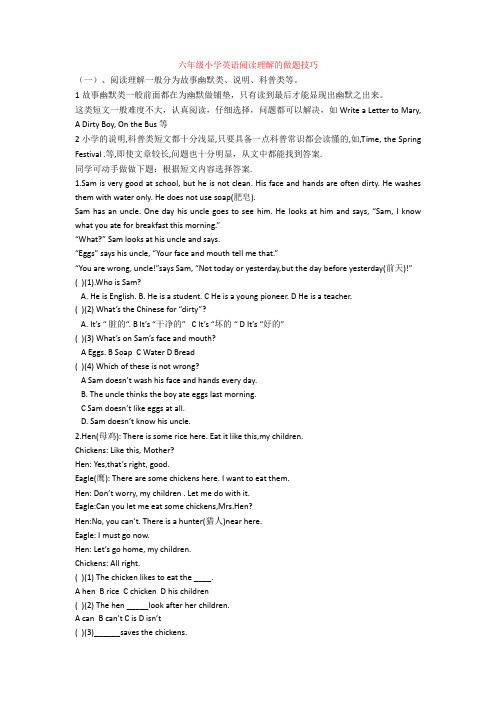
六年级小学英语阅读理解的做题技巧(一)、阅读理解一般分为故事幽默类、说明、科普类等。
1故事幽默类一般前面都在为幽默做铺垫,只有读到最后才能显现出幽默之出来。
这类短文一般难度不大,认真阅读,仔细选择,问题都可以解决,如Write a Letter to Mary, A Dirty Boy, On the Bus 等2小学的说明,科普类短文都十分浅显,只要具备一点科普常识都会读懂的,如,Time, the Spring Festival .等,即使文章较长,问题也十分明显,从文中都能找到答案.同学可动手做做下题:根据短文内容选择答案.1.Sam is very good at school, but he is not clean. His face and hands are often dirty. He washes them with water only. He does not use soap(肥皂).Sam has an uncle. One day his uncle goes to see him. He looks at him and says, “Sam, I know w hat you ate for breakfast this morning.”“What?” Sam looks at his uncle and says.“Eggs” says his uncle, “Your face and mouth tell me that.”“You are wrong, uncle!”says Sam, “Not today or yesterday,but the day before yesterday(前天)!”( )(1).Who is Sam?A. He is English.B. He is a student. C He is a young pioneer. D He is a teacher.( )(2) What’s the Chinese for “dirty”?A. It’s “ 脏的“. B It’s “干净的” C It’s “坏的“ D It’s “好的”( )(3) What’s on Sam’s face and mouth?A Eggs.B SoapC WaterD Bread( )(4) Which of these is not wrong?A Sam doesn’t wash his face and hands every day.B. The uncle thinks the boy ate eggs last morning.C Sam doesn’t like eggs at all.D. Sam doesn’t know his uncle.2.Hen(母鸡): There is some rice here. Eat it like this,my children.Chickens: Like this, Mother?Hen: Yes,that’s right, good.Eagle(鹰): There are some chickens here. I want to eat them.Hen: Don’t worry, my children . Let me do with it.Eagle:Can you let me eat some chickens,Mrs.Hen?Hen:No, you can’t. There is a hunter(猎人)near here.Eagle: I must go now.Hen: Let’s go home, my children.Chickens: All right.( )(1) The chicken likes to eat the ____.A henB riceC chickenD his children( )(2) The hen _____look after her children.A canB can’tC isD isn’t( )(3)______saves the chickens.A The hunter.B The henC The eagleD A man( )(4)The eagle can’t eat_____ at last.A the chickensB go.C the hunterD the hen(二)、解题时有以下几种方法:(1)略读法:关键是在能抓住文章要点的前提下以个人最快的速度阅读,获得足够的信息以便准确地回答有关文章主旨和大意的问题。
六年级小学英语阅读答题技巧+专项训练练习题(含答案解析)

六年级小学英语阅读答题技巧小学英语教学是学生英语学习的启蒙阶段,对学生的终生学习起着重要的作用。
如果小学英语教师能灵活巧妙地渗透、运用英语阅读技巧和策略,帮助小学生有效地学习和阅读英语故事或短文,将会为他们今后的英语学习奠定良好的基础。
下面是小学英语阅读一、先看问题,再读原文先看问题,带着问题去原文里找答案,这样比较有目的性。
现在问题的形式也比较灵活,有单选,有判断正误。
先了解问题具体是哪种形式,在阅读原文的时候才更有针对性寻找答案。
小学阶段的阅读理解相对来说还是比较简单的,很多问题可以在原文里直接找到答案,当然这主要是针对单选和判断来说的。
先读问题,在阅读原文的时候有的问题一下子就出来了,节约了很多时间。
二、通读全文,抓住重点在阅读原文的时候一定不要一句一句的看,一句一句的理解,这样做会影响对整篇文章的理解和认识。
如果遇上生词,先不要管它,略过生词继续通读全文。
读完一遍能够大概明白文章讲了一件什么事。
在阅读的过程中还要注意抓住重点,即出现了哪些人物,提到了什么时间,说到了哪个地点,发生了什么事情,这些关键词最好能用笔在原文中做个记号,因为后面的问题一般都和这些关键词相关。
三、大胆猜词,掌握意思说阅读理解题难很大程度上是因为句子中有些单词不知道是什么意思,这在理解文章意思的时候就会加大难度。
但是我们可以通过猜测单词的意思对通篇文章进行理解,可以根据上下文的意思进行猜测,还可以根据单词的构成进行猜测,比如说我们知道happy是“高兴的”,那么unhappy就是“不高兴的”。
当然这就需要学生在平时注意单词的构成。
四、反复阅读,深刻理解做阅读理解题一般需要读两到三遍,这样对理解全文是非常有帮助的。
第一次阅读把那些能够直接找出答案的题做出来,第二遍阅读就要明白原文具体说了一件什么事情,面白了这个时候对后面一些需要理解能回答的问题这时候就可以解决了。
第三遍通读全文,对所做出的答案再确认一遍。
二、阅读理解2.阅读理解读短文,判断下列句子正误A Farewell PartyDear friends,It's time to leave our school. We are all going to middle school soon,so we will say goodbye to each other. We are going to have a party.Time: Friday, 3 pmPlace: Music RoomActivities: We will listen to music,play games and dance. We will also give presents to all the students.It will be very funny. See you at the party!(1)It's an invitation of a birthday party.(2)They will have the party on Friday.(3)The party will be at three o'clock in the morning.(4)They will meet at the park.(5)They will give presents to all the students and teachers.【答案】(1)0(2)1(3)0(4)0(5)0【考点】阅读理解【解析】【分析】大意:一封欢送会的邀请函。
六年级小学英语阅读理解解题技巧+专项训练练习题(含答案解析)

部编六年级小学英语阅读理解解题技巧阅读理解是综合读者各方面知识的过程,要想快捷、准确地理解所阅读的语篇,考生要明确阅读目的提高阅读层次和技能,加强理解过程的训练,学习中要注意运用5种技巧,提高自己解答阅读理解题的能力。
摒弃6大不良阅读习惯大家可以对照自己是否有以下影响阅读效率的不良习惯。
1.读得非常慢,非常仔细,不相信自己能全部理解所读的东西。
2.阅读时嘴唇和舌头在动。
3.头随着文字符号的位置左右移动。
4.经常回读,读过的东西又重新读一遍、甚至几遍。
5.读什么样体裁的文章都用一样的速度。
6.有很多单词不认识,或不知道它在此处的含义。
如果对上述的问题回答多数是肯定的,那你确实需要提高阅读技能。
如果只有一两项回答是肯定的,那你就需要针对这一两种不良习惯寻找有效的解决方法。
实际解题中,不能盲目地应用快读“技巧”,而要根据不同情况调整阅读速度。
如对场景、人物性格、人物心理刻画要细读。
扩大词汇量有限的词汇量必然影响阅读能力的提高。
生词的含义只有在上下文中才能完全展现出来,并易于被记住、理解和掌握。
换句话说,是上下文给一个词以特定的含义,而这个特定的含义有时是字典无法提供的。
不少教师鼓励学生背句子、段落、整篇文章,都是出于要学生在上下文中理解并掌握词汇和短语。
带着6个问题阅读我建议大家带着下列6个问题阅读:1.作者要表达的主要思想。
2.文章的主要内容和次要内容,并能把他们区分开来。
3.了解并记住文章中最重要的内容。
4.文章结构及事件发生的时间、空间顺序。
5.作者的观点、意图、写作风格及其偏见等。
6.用自己的阅历和知识对文章进行分析、评价。
读完一篇文章后,想一想上述所列出的6项阅读问题,你能把握几项。
阅读是一个判断、推理、归纳、总结的过程,我们需要把分散于文章中的各种信息联系起来,经过必要的判断、推理,得出自己对文章的认识。
遇到生词要会猜阅读中遇到生词,最好的方法是通过上下文猜测。
以下几条建议可帮助你猜测词义:1.看看上下文中有没有生词的另一种说法,即找同义词。
六年级小学英语阅读理解技巧与训练+专项训练练习题(含答案解析)
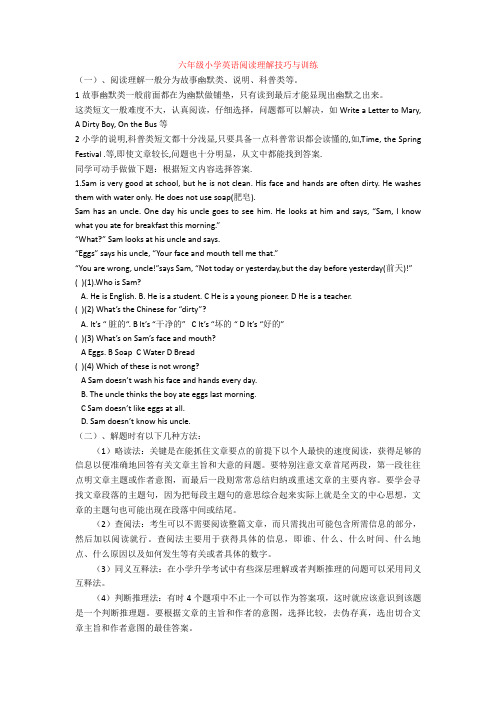
六年级小学英语阅读理解技巧与训练(一)、阅读理解一般分为故事幽默类、说明、科普类等。
1故事幽默类一般前面都在为幽默做铺垫,只有读到最后才能显现出幽默之出来。
这类短文一般难度不大,认真阅读,仔细选择,问题都可以解决,如Write a Letter to Mary, A Dirty Boy, On the Bus 等2小学的说明,科普类短文都十分浅显,只要具备一点科普常识都会读懂的,如,Time, the Spring Festival .等,即使文章较长,问题也十分明显,从文中都能找到答案.同学可动手做做下题:根据短文内容选择答案.1.Sam is very good at school, but he is not clean. His face and hands are often dirty. He washes them with water only. He does not use soap(肥皂).Sam has an uncle. One day his uncle goes to see him. He looks at him and says, “Sam, I know w hat you ate for breakfast this morning.”“What?” Sam looks at his uncle and says.“Eggs” says his uncle, “Your face and mouth tell me that.”“You are wrong, uncle!”says Sam, “Not today or yesterday,but the day before yesterday(前天)!”( )(1).Who is Sam?A. He is English.B. He is a student. C He is a young pioneer. D He is a teacher.( )(2) What’s the Chinese for “dirty”?A. It’s “ 脏的“. B It’s “干净的” C It’s “坏的“ D It’s “好的”( )(3) What’s on Sam’s face and mouth?A Eggs.B SoapC WaterD Bread( )(4) Which of these is not wrong?A Sam doesn’t wash his face and hands every day.B. The uncle thinks the boy ate eggs last morning.C Sam doesn’t like eggs at all.D. Sam doesn’t know his uncle.(二)、解题时有以下几种方法:(1)略读法:关键是在能抓住文章要点的前提下以个人最快的速度阅读,获得足够的信息以便准确地回答有关文章主旨和大意的问题。
六年级英语阅读理解应试技巧+专项训练练习题(含答案解析)
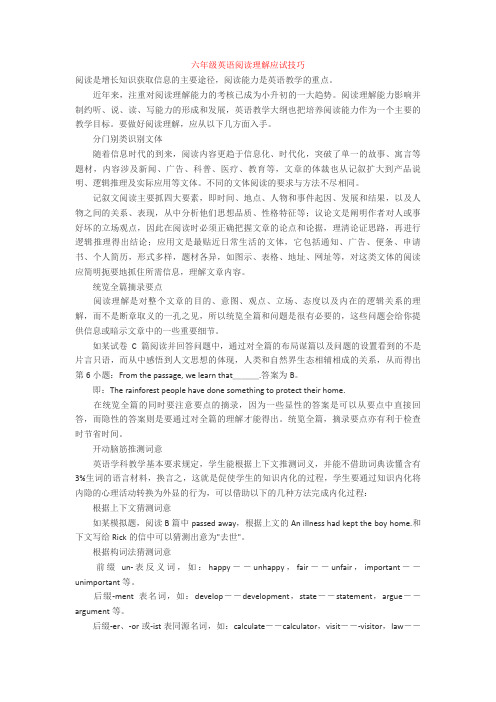
六年级英语阅读理解应试技巧阅读是增长知识获取信息的主要途径,阅读能力是英语教学的重点。
近年来,注重对阅读理解能力的考核已成为小升初的一大趋势。
阅读理解能力影响并制约听、说、读、写能力的形成和发展,英语教学大纲也把培养阅读能力作为一个主要的教学目标。
要做好阅读理解,应从以下几方面入手。
分门别类识别文体随着信息时代的到来,阅读内容更趋于信息化、时代化,突破了单一的故事、寓言等题材,内容涉及新闻、广告、科普、医疗、教育等,文章的体裁也从记叙扩大到产品说明、逻辑推理及实际应用等文体。
不同的文体阅读的要求与方法不尽相同。
记叙文阅读主要抓四大要素,即时间、地点、人物和事件起因、发展和结果,以及人物之间的关系、表现,从中分析他们思想品质、性格特征等;议论文是阐明作者对人或事好坏的立场观点,因此在阅读时必须正确把握文章的论点和论据,理清论证思路,再进行逻辑推理得出结论;应用文是最贴近日常生活的文体,它包括通知、广告、便条、申请书、个人简历,形式多样,题材各异,如图示、表格、地址、网址等,对这类文体的阅读应简明扼要地抓住所需信息,理解文章内容。
统览全篇摘录要点阅读理解是对整个文章的目的、意图、观点、立场、态度以及内在的逻辑关系的理解,而不是断章取义的一孔之见,所以统览全篇和问题是很有必要的,这些问题会给你提供信息或暗示文章中的一些重要细节。
如某试卷C篇阅读并回答问题中,通过对全篇的布局谋篇以及问题的设置看到的不是片言只语,而从中感悟到人文思想的体现,人类和自然界生态相辅相成的关系,从而得出第6小题:From the passage, we learn that___.答案为B。
即:The rainforest people have done something to protect their home.在统览全篇的同时要注意要点的摘录,因为一些显性的答案是可以从要点中直接回答,而隐性的答案则是要通过对全篇的理解才能得出。
六年级小学英语阅读答题技巧+专项训练练习题(含答案解析)
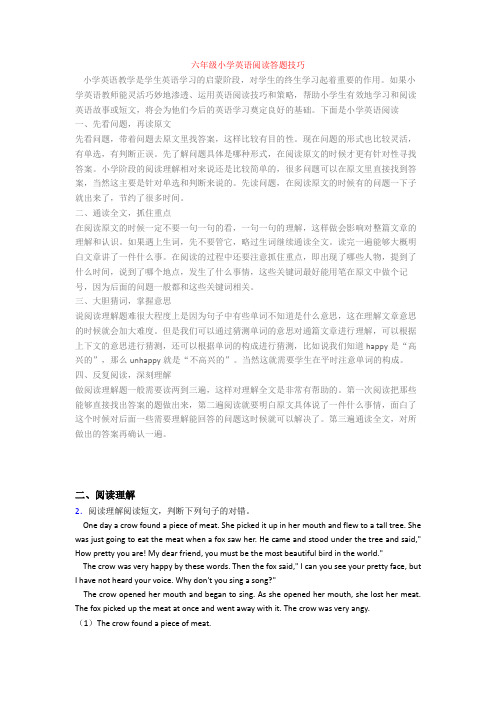
六年级小学英语阅读答题技巧小学英语教学是学生英语学习的启蒙阶段,对学生的终生学习起着重要的作用。
如果小学英语教师能灵活巧妙地渗透、运用英语阅读技巧和策略,帮助小学生有效地学习和阅读英语故事或短文,将会为他们今后的英语学习奠定良好的基础。
下面是小学英语阅读一、先看问题,再读原文先看问题,带着问题去原文里找答案,这样比较有目的性。
现在问题的形式也比较灵活,有单选,有判断正误。
先了解问题具体是哪种形式,在阅读原文的时候才更有针对性寻找答案。
小学阶段的阅读理解相对来说还是比较简单的,很多问题可以在原文里直接找到答案,当然这主要是针对单选和判断来说的。
先读问题,在阅读原文的时候有的问题一下子就出来了,节约了很多时间。
二、通读全文,抓住重点在阅读原文的时候一定不要一句一句的看,一句一句的理解,这样做会影响对整篇文章的理解和认识。
如果遇上生词,先不要管它,略过生词继续通读全文。
读完一遍能够大概明白文章讲了一件什么事。
在阅读的过程中还要注意抓住重点,即出现了哪些人物,提到了什么时间,说到了哪个地点,发生了什么事情,这些关键词最好能用笔在原文中做个记号,因为后面的问题一般都和这些关键词相关。
三、大胆猜词,掌握意思说阅读理解题难很大程度上是因为句子中有些单词不知道是什么意思,这在理解文章意思的时候就会加大难度。
但是我们可以通过猜测单词的意思对通篇文章进行理解,可以根据上下文的意思进行猜测,还可以根据单词的构成进行猜测,比如说我们知道happy是“高兴的”,那么unhappy就是“不高兴的”。
当然这就需要学生在平时注意单词的构成。
四、反复阅读,深刻理解做阅读理解题一般需要读两到三遍,这样对理解全文是非常有帮助的。
第一次阅读把那些能够直接找出答案的题做出来,第二遍阅读就要明白原文具体说了一件什么事情,面白了这个时候对后面一些需要理解能回答的问题这时候就可以解决了。
第三遍通读全文,对所做出的答案再确认一遍。
二、阅读理解2.阅读理解阅读短文,判断下列句子的对错。
六年级小学英语阅读理解的解题技巧+专项训练练习题(含答案解析)

部编六年级小学英语阅读理解的解题技巧(一)、阅读理解一般分为故事幽默类、说明、科普类等。
1故事幽默类一般前面都在为幽默做铺垫,只有读到最后才能显现出幽默之出来。
这类短文一般难度不大,认真阅读,仔细选择,问题都可以解决,如Write a Letter to Mary, A Dirty Boy, On the Bus 等2小学的说明,科普类短文都十分浅显,只要具备一点科普常识都会读懂的,如,Time, the Spring Festival .等,即使文章较长,问题也十分明显,从文中都能找到答案.同学可动手做做下题:根据短文内容选择答案.1.Sam is very good at school, but he is not clean. His face and hands are often dirty. He washes them with water only. He does not use soap(肥皂).Sam has an uncle. One day his uncle goes to see him. He looks at him and says, “Sam, I know what you ate for breakfast this morning.”“What?” Sam looks at his uncle and says.“Eggs” says his uncle, “Your face and mouth tell me that.”“You are wrong, uncle!”says Sam, “Not today or yesterday,but the day before yesterday(前天)!”( )(1).Who is Sam?A. He is English.B. He is a student. C He is a young pioneer. D He is a teacher.( )(2) What’s the Chinese for “dirty”?A. It’s “ 脏的“. B It’s “干净的” C It’s “坏的“ D It’s “好的”( )(3) What’s on Sam’s face and mouth?A Eggs.B SoapC WaterD Bread( )(4) Which of these is not wrong?A Sam doesn’t wash his face and hands every day.B. The uncle thinks the boy ate eggs last morning.C Sam doesn’t like eggs at all.D. Sam doesn’t know his uncle.(二)、解题时有以下几种方法:(1)略读法:关键是在能抓住文章要点的前提下以个人最快的速度阅读,获得足够的信息以便准确地回答有关文章主旨和大意的问题。
六年级英语阅读理解应试技巧+专项训练练习题(含答案解析) (2)
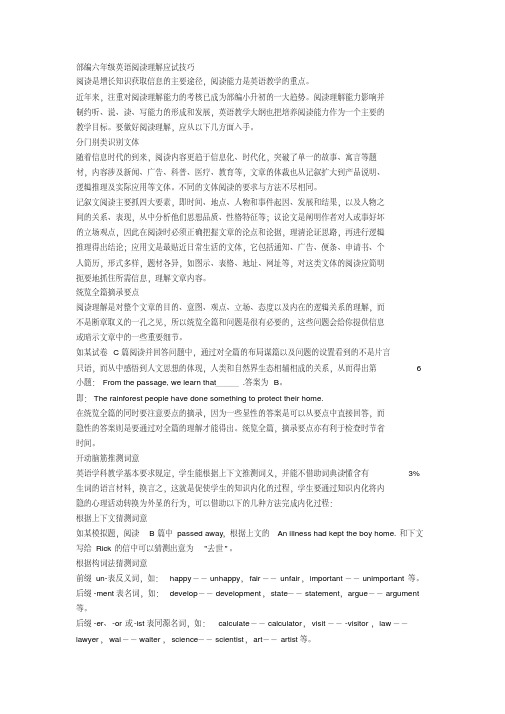
在统览全篇的同时要注意要点的摘录,因为一些显性的答案是可以从要点中直接回答,而 隐性的答案则是要通过对全篇的理解才能得出。统览全篇,摘录要点亦有利于检查时节省
时间。 开动脑筋推测词意
英语学科教学基本要求规定,学生能根据上下文推测词义,并能不借助词典读懂含有
3%
生词的语言材料,换言之,这就是促使学生的知识内化的过程,学生要通过知识内化将内
语。经过分析,化整为零,化繁为简,此句就不难理解了。
二、阅读理解
2. 阅读理解 (一)
It's Saturday afternoon. What is my family doing? My mother is in the kitchen. She is cooking.
We will have potatoes and some meat for dinner. I like them. My father is in his bedroom. He is
flowers. They are very beautiful. I am in the study. I'm reading a book. It's interesting. I like it very
much. This is a wonderful afternoon.
根据短文内容补全信息。
等。如: Parents whose children show a special interesting particular sport have a difficult
decision to make about their children's career. 先找出本句的主、谓、宾为 Parents have a cession. 再找出修饰语 Whose children show a special interesting particular sport. 为 Parents的定语从 句, difficult 修饰 decision ,to make about their children's careers 为不定式做 decision 的定
六年级小学英语阅读理解解题技巧+专项训练练习题(含答案解析)

六年级小学英语阅读理解解题技巧阅读理解是综合读者各方面知识的过程,要想快捷、准确地理解所阅读的语篇,考生要明确阅读目的提高阅读层次和技能,加强理解过程的训练,学习中要注意运用5种技巧,提高自己解答阅读理解题的能力。
摒弃6大不良阅读习惯大家可以对照自己是否有以下影响阅读效率的不良习惯。
1.读得非常慢,非常仔细,不相信自己能全部理解所读的东西。
2.阅读时嘴唇和舌头在动。
3.头随着文字符号的位置左右移动。
4.经常回读,读过的东西又重新读一遍、甚至几遍。
5.读什么样体裁的文章都用一样的速度。
6.有很多单词不认识,或不知道它在此处的含义。
如果对上述的问题回答多数是肯定的,那你确实需要提高阅读技能。
如果只有一两项回答是肯定的,那你就需要针对这一两种不良习惯寻找有效的解决方法。
实际解题中,不能盲目地应用快读“技巧”,而要根据不同情况调整阅读速度。
如对场景、人物性格、人物心理刻画要细读。
扩大词汇量有限的词汇量必然影响阅读能力的提高。
生词的含义只有在上下文中才能完全展现出来,并易于被记住、理解和掌握。
换句话说,是上下文给一个词以特定的含义,而这个特定的含义有时是字典无法提供的。
不少教师鼓励学生背句子、段落、整篇文章,都是出于要学生在上下文中理解并掌握词汇和短语。
带着6个问题阅读我建议大家带着下列6个问题阅读:1.作者要表达的主要思想。
2.文章的主要内容和次要内容,并能把他们区分开来。
3.了解并记住文章中最重要的内容。
4.文章结构及事件发生的时间、空间顺序。
5.作者的观点、意图、写作风格及其偏见等。
6.用自己的阅历和知识对文章进行分析、评价。
读完一篇文章后,想一想上述所列出的6项阅读问题,你能把握几项。
阅读是一个判断、推理、归纳、总结的过程,我们需要把分散于文章中的各种信息联系起来,经过必要的判断、推理,得出自己对文章的认识。
遇到生词要会猜阅读中遇到生词,最好的方法是通过上下文猜测。
以下几条建议可帮助你猜测词义:1.看看上下文中有没有生词的另一种说法,即找同义词。
[必刷题]2024六年级英语上册阅读理解技巧专项专题训练(含答案)
![[必刷题]2024六年级英语上册阅读理解技巧专项专题训练(含答案)](https://img.taocdn.com/s3/m/51739272657d27284b73f242336c1eb91b373304.png)
[必刷题]2024六年级英语上册阅读理解技巧专项专题训练(含答案)试题部分一、选择题:1. Which of the following is a good way to improve reading prehension skills?A. Reading aloudB. Speed readingC. SkimmingD. All of the above2. When reading a passage, what should you do first?A. Read the questionsB. Read the passage carefullyC. Look at the picturesD. Skip the hard parts3. Which of the following is NOT a reading prehension strategy?A. Making predictionsB. Asking questionsC. daydreamingD. Summarizing4. What is the main idea of a passage?A. The first sentenceB. The last sentenceC. The most important pointD. All the details5. When encountering a difficult word in a passage, what should you do?A. Look it up in a dictionaryB. Ignore itC. Ask the teacherD. Guess its meaning from the context6. Which of the following is a good way to check your understanding of a passage?A. Reread the passageB. Answer the questions without reading the passageC. Read the questions first, then the passageD. Read the passage as fast as possible7. What is the purpose of reading subheadings in a passage?A. To find the main ideaB. To understand the structureC. To skip the irrelevant partsD. To find the answers to the questions8. Which of the following is a good tip for improving reading speed?A. Read every word carefullyB. Practice reading with a timerC. Read the passage backwardsD. Read the passage out loud9. What is the difference between skimming and scanning?A. Skimming is reading quickly for the main idea, while scanning is looking for specific informationB. Scanning is reading quickly for the main idea, while skimming is looking for specific informationC. Skimming and scanning are the same thingD. Skimming is reading slowly, while scanning is reading quickly10. Which of the following is NOT a part of reading prehension?A. VocabularyB. GrammarC. InferenceD. Understanding the author's purpose二、判断题:1. Reading prehension skills are only important for English exams. (×)2. It is necessary to read the questions before reading the passage. (√)3. Speed reading is always better than careful reading. (×)4. Making predictions while reading can help improve prehension. (√)5. The main idea of a passage is always found in thefirst sentence. (×)三、填空题:1. Reading prehension is an essential skill for students to master, especially in the field of ________.2. Before reading a passage, it's important to ________ to get a general idea of what the text is about.3. One effective strategy for improving reading prehension is to practice ________ regularly.4. To understand the author's purpose, readers should pay attention to the ________ of the text.5. When encountering an unfamiliar word, a good approach is to ________ the word's meaning from the context.6. ________ is a technique that helps readers quickly identify the main points of a text.7. ________ is the process of reading a text in detail to understand every part of it.8. ________ questions are often used to test readers' ability to make logical inferences from the text.9. The ________ of a passage is the central idea that the author wants to convey.10. ________ is an important part of reading prehension that involves understanding the relationships between words and phrases.11. To check prehension, readers can ________ the text to see if their understanding aligns with the author's message.12. ________ is a skill that helps readers identify the author's attitude or bias.13. ________ involves understanding the sequence of events or steps described in the text.14. ________ is the ability to make sense of diagrams, charts, and other visual information in a text.15. ________ is a skill that allows readers to connect new information with what they already know.16. ________ reading is a strategy that involves readinga text quickly to get the main idea.17. ________ reading is a strategy that involves searching for specific details in a text.18. ________ is the ability to determine the meaning of a word based on how it is used in a sentence.19. ________ is a skill that helps readers understand the cause and effect relationships in a text.20. ________ is the ability to evaluate the effectiveness of the author's arguments and evidence.四、简答题:1. Explain the importance of reading prehension in academic success.2. Describe two strategies that can help improve reading prehension.3. How can students determine the main idea of a passage?4. What is the difference between skimming and scanning, and when is each technique most useful?5. Why is it important to make predictions while readinga text?6. How can students use context clues to understand the meaning of unfamiliar words?7. What is inference, and how does it relate to reading prehension?8. How can students check their understanding of a text after reading it?9. What role does vocabulary play in reading prehension?10. How can students develop their critical thinking skills through reading prehension exercises?本套试题答案如下一、选择题:1. D2. A3. C4. C5. D6. A7. B8. B9. A10. B二、判断题:1. ×2. √3. ×4. √5. ×三、填空题:1. English2. preview3. reading4. tone5. infer6. Skimming7. Close reading8. Inference9. Theme10. Vocabulary11. reread12. Evaluation13. Sequencing14. Interpretation15. Making connections16. Skimming17. Scanning18. Word analysis19. Cause and effect20. Critical thinking四、简答题:1. It is crucial for understanding and retaining information, which is essential for success in all academic subjects.2. Reading aloud and summarizing information.3. By identifying the topic and the main points the author makes about the topic.4. Skimming is reading quickly to get the main idea, useful when you need a quick overview. Scanning is searching for specific details, useful when you need to find specific information quickly.5. It helps engage the reader and activate prior knowledge.6. By looking at the words and sentences around the unfamiliar word.7. Inference is making logical guesses based on clues in the text, which is a key part of understanding the text.8. By summarizing the text in their own words or answering questions about the text.9. It helps readers understand and interpret the text.10. By analyzing the author's arguments and evidence, and making connections and inferences.。
【英语】六年级小学英语阅读理解的做题技巧+专项训练练习题(含答案解析)
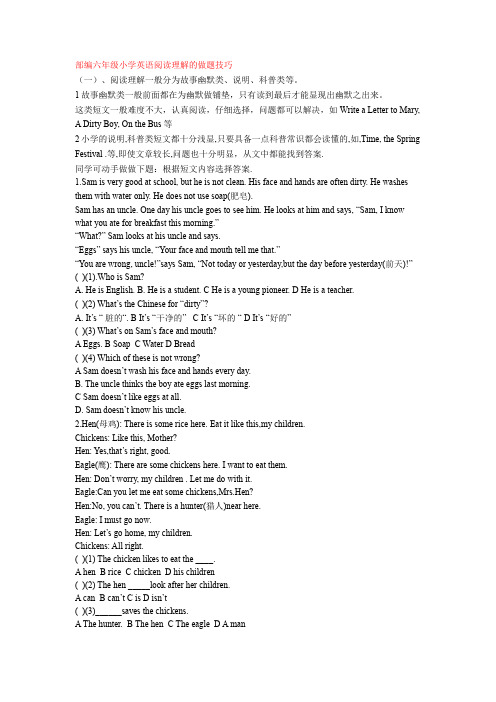
部编六年级小学英语阅读理解的做题技巧(一)、阅读理解一般分为故事幽默类、说明、科普类等。
1故事幽默类一般前面都在为幽默做铺垫,只有读到最后才能显现出幽默之出来。
这类短文一般难度不大,认真阅读,仔细选择,问题都可以解决,如Write a Letter to Mary, A Dirty Boy, On the Bus 等2小学的说明,科普类短文都十分浅显,只要具备一点科普常识都会读懂的,如,Time, the Spring Festival .等,即使文章较长,问题也十分明显,从文中都能找到答案.同学可动手做做下题:根据短文内容选择答案.1.Sam is very good at school, but he is not clean. His face and hands are often dirty. He washes them with water only. He does not use soap(肥皂).Sam has an uncle. One day his uncle goes to see him. He looks at him and says, “Sam, I know what you ate for breakfast this morning.”“What?” Sam looks at his uncle and says.“Eggs” says his uncle, “Your face and mouth tell me that.”“You are wrong, uncle!”says Sam, “Not today or yesterday,but the day before yesterday(前天)!”( )(1).Who is Sam?A. He is English.B. He is a student. C He is a young pioneer. D He is a teacher.( )(2) What’s the Chinese for “dirty”?A. It’s “ 脏的“. B It’s “干净的” C It’s “坏的“ D It’s “好的”( )(3) What’s on Sam’s face and mouth?A Eggs.B SoapC WaterD Bread( )(4) Which of these is not wrong?A Sam doesn’t wash his face and hands every day.B. The uncle thinks the boy ate eggs last morning.C Sam doesn’t like eggs at all.D. Sam doesn’t know his uncle.2.Hen(母鸡): There is some rice here. Eat it like this,my children.Chickens: Like this, Mother?Hen: Yes,that’s right, good.Eagle(鹰): There are some chickens here. I want to eat them.Hen: Don’t worry, my children . Let me do with it.Eagle:Can you let me eat some chickens,Mrs.Hen?Hen:No, you can’t. There is a hunter(猎人)near here.Eagle: I must go now.Hen: Let’s go home, my children.Chickens: All right.( )(1) The chicken likes to eat the ____.A henB riceC chickenD his children( )(2) The hen _____look after her children.A canB can’tC isD isn’t( )(3)______saves the chickens.A The hunter.B The henC The eagleD A man( )(4)The eagle can’t eat_____ at last.A the chickensB go.C the hunterD the hen(二)、解题时有以下几种方法:(1)略读法:关键是在能抓住文章要点的前提下以个人最快的速度阅读,获得足够的信息以便准确地回答有关文章主旨和大意的问题。
六年级英语阅读题型及解题技巧+专项训练练习题(含答案解析)
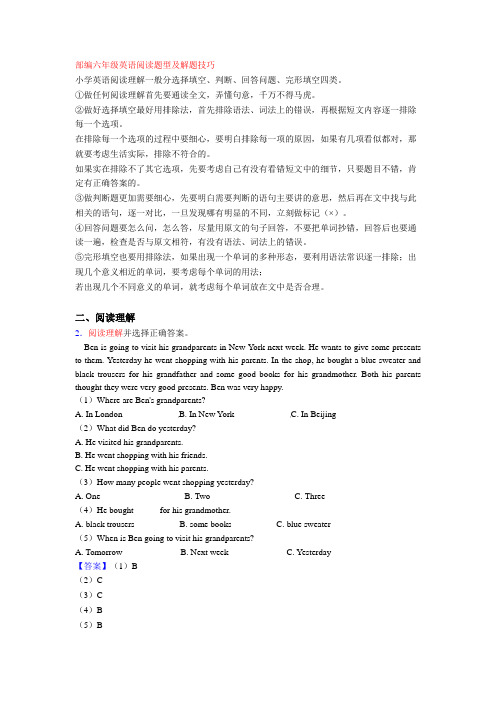
部编六年级英语阅读题型及解题技巧小学英语阅读理解一般分选择填空、判断、回答问题、完形填空四类。
①做任何阅读理解首先要通读全文,弄懂句意,千万不得马虎。
②做好选择填空最好用排除法,首先排除语法、词法上的错误,再根据短文内容逐一排除每一个选项。
在排除每一个选项的过程中要细心,要明白排除每一项的原因,如果有几项看似都对,那就要考虑生活实际,排除不符合的。
如果实在排除不了其它选项,先要考虑自己有没有看错短文中的细节,只要题目不错,肯定有正确答案的。
③做判断题更加需要细心,先要明白需要判断的语句主要讲的意思,然后再在文中找与此相关的语句,逐一对比,一旦发现哪有明显的不同,立刻做标记(×)。
④回答问题要怎么问,怎么答,尽量用原文的句子回答,不要把单词抄错,回答后也要通读一遍,检查是否与原文相符,有没有语法、词法上的错误。
⑤完形填空也要用排除法,如果出现一个单词的多种形态,要利用语法常识逐一排除;出现几个意义相近的单词,要考虑每个单词的用法;若出现几个不同意义的单词,就考虑每个单词放在文中是否合理。
二、阅读理解2.阅读理解并选择正确答案。
Ben is going to visit his grandparents in New York next week. He wants to give some presents to them. Yesterday he went shopping with his parents. In the shop, he bought a blue sweater and black trousers for his grandfather and some good books for his grandmother. Both his parents thought they were very good presents. Ben was very happy.(1)Where are Ben's grandparents?A. In LondonB. In New YorkC. In Beijing(2)What did Ben do yesterday?A. He visited his grandparents.B. He went shopping with his friends.C. He went shopping with his parents.(3)How many people went shopping yesterday?A. OneB. TwoC. Three(4)He bought _____ for his grandmother.A. black trousersB. some booksC. blue sweater(5)When is Ben going to visit his grandparents?A. TomorrowB. Next weekC. Yesterday【答案】(1)B(2)C(3)C(4)B(5)B【解析】【分析】文章大意:描述Ben打算探望祖父母的事情。
六年级小学英语阅读理解技巧与训练+专项训练练习题(含答案解析)
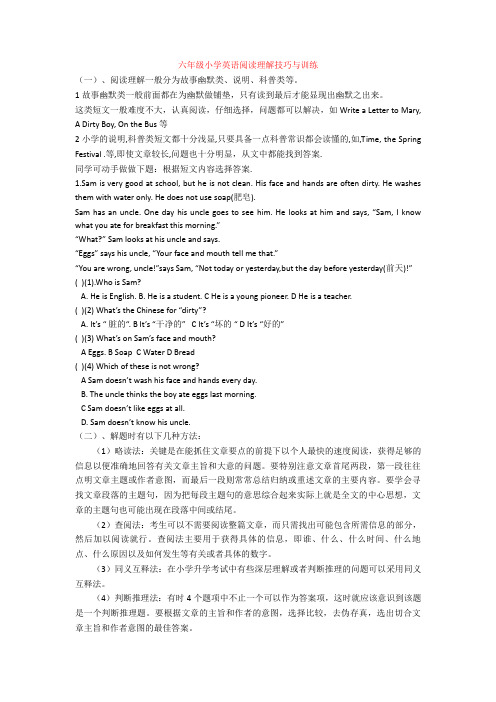
六年级小学英语阅读理解技巧与训练(一)、阅读理解一般分为故事幽默类、说明、科普类等。
1故事幽默类一般前面都在为幽默做铺垫,只有读到最后才能显现出幽默之出来。
这类短文一般难度不大,认真阅读,仔细选择,问题都可以解决,如Write a Letter to Mary, A Dirty Boy, On the Bus 等2小学的说明,科普类短文都十分浅显,只要具备一点科普常识都会读懂的,如,Time, the Spring Festival .等,即使文章较长,问题也十分明显,从文中都能找到答案.同学可动手做做下题:根据短文内容选择答案.1.Sam is very good at school, but he is not clean. His face and hands are often dirty. He washes them with water only. He does not use soap(肥皂).Sam has an uncle. One day his uncle goes to see him. He looks at him and says, “Sam, I know w hat you ate for breakfast this morning.”“What?” Sam looks at his uncle and says.“Eggs” says his uncle, “Your face and mouth tell me that.”“You are wrong, uncle!”says Sam, “Not today or yesterday,but the day before yesterday(前天)!”( )(1).Who is Sam?A. He is English.B. He is a student. C He is a young pioneer. D He is a teacher.( )(2) What’s the Chinese for “dirty”?A. It’s “ 脏的“. B It’s “干净的” C It’s “坏的“ D It’s “好的”( )(3) What’s on Sam’s face and mouth?A Eggs.B SoapC WaterD Bread( )(4) Which of these is not wrong?A Sam doesn’t wash his face and hands every day.B. The uncle thinks the boy ate eggs last morning.C Sam doesn’t like eggs at all.D. Sam doesn’t know his uncle.(二)、解题时有以下几种方法:(1)略读法:关键是在能抓住文章要点的前提下以个人最快的速度阅读,获得足够的信息以便准确地回答有关文章主旨和大意的问题。
六年级小学英语阅读理解的解题技巧+专项训练练习题(含答案解析)
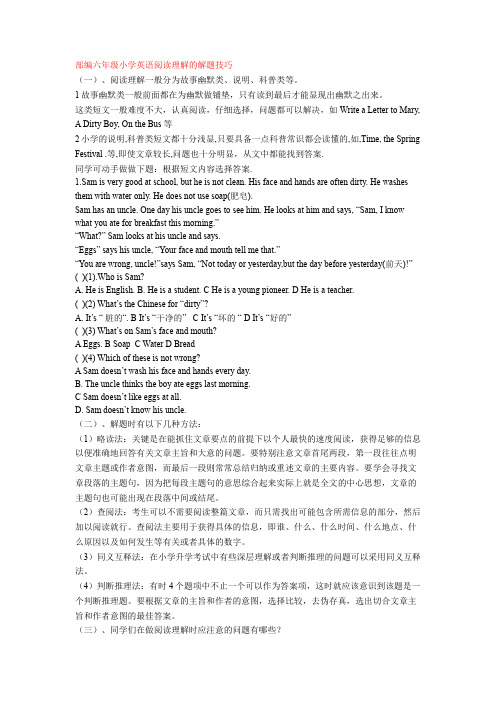
部编六年级小学英语阅读理解的解题技巧(一)、阅读理解一般分为故事幽默类、说明、科普类等。
1故事幽默类一般前面都在为幽默做铺垫,只有读到最后才能显现出幽默之出来。
这类短文一般难度不大,认真阅读,仔细选择,问题都可以解决,如Write a Letter to Mary, A Dirty Boy, On the Bus 等2小学的说明,科普类短文都十分浅显,只要具备一点科普常识都会读懂的,如,Time, the Spring Festival .等,即使文章较长,问题也十分明显,从文中都能找到答案.同学可动手做做下题:根据短文内容选择答案.1.Sam is very good at school, but he is not clean. His face and hands are often dirty. He washes them with water only. He does not use soap(肥皂).Sam has an uncle. One day his uncle goes to see him. He looks at him and says, “Sam, I know what you ate for breakfast this morning.”“What?” Sam looks at his uncle and says.“Eggs” says his uncle, “Your face and mouth tell me that.”“You are wrong, uncle!”says Sam, “Not today or yesterday,but the day before yesterday(前天)!”( )(1).Who is Sam?A. He is English.B. He is a student. C He is a young pioneer. D He is a teacher.( )(2) What’s the Chinese for “dirty”?A. It’s “ 脏的“. B It’s “干净的” C It’s “坏的“ D It’s “好的”( )(3) What’s on Sam’s face and mouth?A Eggs.B SoapC WaterD Bread( )(4) Which of these is not wrong?A Sam doesn’t wash his face and hands every day.B. The uncle thinks the boy ate eggs last morning.C Sam doesn’t like eggs at all.D. Sam doesn’t know his uncle.(二)、解题时有以下几种方法:(1)略读法:关键是在能抓住文章要点的前提下以个人最快的速度阅读,获得足够的信息以便准确地回答有关文章主旨和大意的问题。
六年级小学英语阅读理解技巧与训练+专项训练练习题(含答案解析)
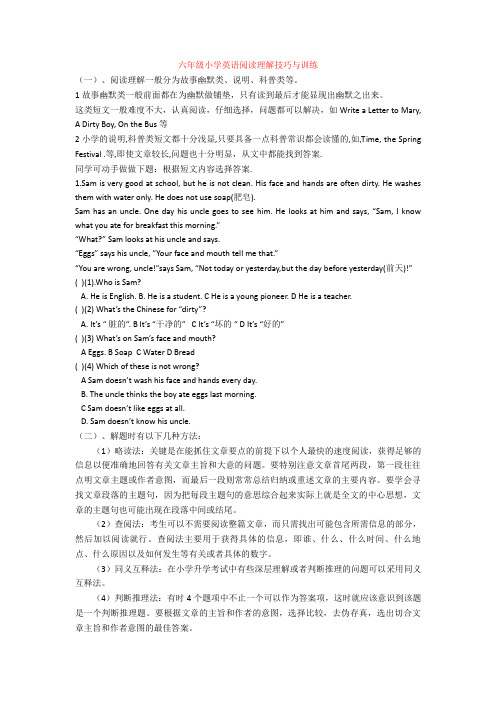
六年级小学英语阅读理解技巧与训练(一)、阅读理解一般分为故事幽默类、说明、科普类等。
1故事幽默类一般前面都在为幽默做铺垫,只有读到最后才能显现出幽默之出来。
这类短文一般难度不大,认真阅读,仔细选择,问题都可以解决,如Write a Letter to Mary, A Dirty Boy, On the Bus 等2小学的说明,科普类短文都十分浅显,只要具备一点科普常识都会读懂的,如,Time, the Spring Festival .等,即使文章较长,问题也十分明显,从文中都能找到答案.同学可动手做做下题:根据短文内容选择答案.1.Sam is very good at school, but he is not clean. His face and hands are often dirty. He washes them with water only. He does not use soap(肥皂).Sam has an uncle. One day his uncle goes to see him. He looks at him and says, “Sam, I know w hat you ate for breakfast this morning.”“What?” Sam looks at his uncle and says.“Eggs” says his uncle, “Your face and mouth tell me that.”“You are wrong, uncle!”says Sam, “Not today or yesterday,but the day before yesterday(前天)!”( )(1).Who is Sam?A. He is English.B. He is a student. C He is a young pioneer. D He is a teacher.( )(2) What’s the Chinese for “dirty”?A. It’s “ 脏的“. B It’s “干净的” C It’s “坏的“ D It’s “好的”( )(3) What’s on Sam’s face and mouth?A Eggs.B SoapC WaterD Bread( )(4) Which of these is not wrong?A Sam doesn’t wash his face and hands every day.B. The uncle thinks the boy ate eggs last morning.C Sam doesn’t like eggs at all.D. Sam doesn’t know his uncle.(二)、解题时有以下几种方法:(1)略读法:关键是在能抓住文章要点的前提下以个人最快的速度阅读,获得足够的信息以便准确地回答有关文章主旨和大意的问题。
六年级小学英语阅读理解解题技巧+专项训练练习题(答案解析)

部编六年级小学英语阅读理解解题技巧阅读理解是综合读者各方面知识的过程,要想快捷、准确地理解所阅读的语篇,考生要明确阅读目的提高阅读层次和技能,加强理解过程的训练,学习中要注意运用5种技巧,提高自己解答阅读理解题的能力。
摒弃6大不良阅读习惯大家可以对照自己是否有以下影响阅读效率的不良习惯。
1.读得非常慢,非常仔细,不相信自己能全部理解所读的东西。
2.阅读时嘴唇和舌头在动。
3.头随着文字符号的位置左右移动。
4.经常回读,读过的东西又重新读一遍、甚至几遍。
5.读什么样体裁的文章都用一样的速度。
6.有很多单词不认识,或不知道它在此处的含义。
如果对上述的问题回答多数是肯定的,那你确实需要提高阅读技能。
如果只有一两项回答是肯定的,那你就需要针对这一两种不良习惯寻找有效的解决方法。
实际解题中,不能盲目地应用快读“技巧”,而要根据不同情况调整阅读速度。
如对场景、人物性格、人物心理刻画要细读。
扩大词汇量有限的词汇量必然影响阅读能力的提高。
生词的含义只有在上下文中才能完全展现出来,并易于被记住、理解和掌握。
换句话说,是上下文给一个词以特定的含义,而这个特定的含义有时是字典无法提供的。
不少教师鼓励学生背句子、段落、整篇文章,都是出于要学生在上下文中理解并掌握词汇和短语。
带着6个问题阅读我建议大家带着下列6个问题阅读:1.作者要表达的主要思想。
2.文章的主要内容和次要内容,并能把他们区分开来。
3.了解并记住文章中最重要的内容。
4.文章结构及事件发生的时间、空间顺序。
5.作者的观点、意图、写作风格及其偏见等。
6.用自己的阅历和知识对文章进行分析、评价。
读完一篇文章后,想一想上述所列出的6项阅读问题,你能把握几项。
阅读是一个判断、推理、归纳、总结的过程,我们需要把分散于文章中的各种信息联系起来,经过必要的判断、推理,得出自己对文章的认识。
遇到生词要会猜阅读中遇到生词,最好的方法是通过上下文猜测。
以下几条建议可帮助你猜测词义:1.看看上下文中有没有生词的另一种说法,即找同义词。
- 1、下载文档前请自行甄别文档内容的完整性,平台不提供额外的编辑、内容补充、找答案等附加服务。
- 2、"仅部分预览"的文档,不可在线预览部分如存在完整性等问题,可反馈申请退款(可完整预览的文档不适用该条件!)。
- 3、如文档侵犯您的权益,请联系客服反馈,我们会尽快为您处理(人工客服工作时间:9:00-18:30)。
六年级英语阅读理解应试技巧阅读是增长知识获取信息的主要途径,阅读能力是英语教学的重点。
近年来,注重对阅读理解能力的考核已成为小升初的一大趋势。
阅读理解能力影响并制约听、说、读、写能力的形成和发展,英语教学大纲也把培养阅读能力作为一个主要的教学目标。
要做好阅读理解,应从以下几方面入手。
分门别类识别文体随着信息时代的到来,阅读内容更趋于信息化、时代化,突破了单一的故事、寓言等题材,内容涉及新闻、广告、科普、医疗、教育等,文章的体裁也从记叙扩大到产品说明、逻辑推理及实际应用等文体。
不同的文体阅读的要求与方法不尽相同。
记叙文阅读主要抓四大要素,即时间、地点、人物和事件起因、发展和结果,以及人物之间的关系、表现,从中分析他们思想品质、性格特征等;议论文是阐明作者对人或事好坏的立场观点,因此在阅读时必须正确把握文章的论点和论据,理清论证思路,再进行逻辑推理得出结论;应用文是最贴近日常生活的文体,它包括通知、广告、便条、申请书、个人简历,形式多样,题材各异,如图示、表格、地址、网址等,对这类文体的阅读应简明扼要地抓住所需信息,理解文章内容。
统览全篇摘录要点阅读理解是对整个文章的目的、意图、观点、立场、态度以及内在的逻辑关系的理解,而不是断章取义的一孔之见,所以统览全篇和问题是很有必要的,这些问题会给你提供信息或暗示文章中的一些重要细节。
如某试卷C篇阅读并回答问题中,通过对全篇的布局谋篇以及问题的设置看到的不是片言只语,而从中感悟到人文思想的体现,人类和自然界生态相辅相成的关系,从而得出第6小题:From the passage, we learn that___.答案为B。
即:The rainforest people have done something to protect their home.在统览全篇的同时要注意要点的摘录,因为一些显性的答案是可以从要点中直接回答,而隐性的答案则是要通过对全篇的理解才能得出。
统览全篇,摘录要点亦有利于检查时节省时间。
开动脑筋推测词意英语学科教学基本要求规定,学生能根据上下文推测词义,并能不借助词典读懂含有3%生词的语言材料,换言之,这就是促使学生的知识内化的过程,学生要通过知识内化将内隐的心理活动转换为外显的行为,可以借助以下的几种方法完成内化过程:根据上下文猜测词意如某模拟题,阅读B篇中passed away,根据上文的An illness had kept the boy home.和下文写给Rick的信中可以猜测出意为"去世"。
根据构词法猜测词意前缀un-表反义词,如:happy--unhappy,fair--unfair,important--unimportant等。
后缀-ment表名词,如:develop--development,state--statement,argue--argument等。
后缀-er、-or或-ist表同源名词,如:calculate--calculator,visit---visitor,law--lawyer,wai--waiter,science--scientist,art--artist等。
用知识和生活经验理解短文如:根据化学知识,可以理解科普读物Water is made from oxygen and hydrogen.根据生活经验可以理解Green plants let out oxygen and breathe in carbon dioxide.根据逻辑推理理解短文逻辑推理实际上就是文章的"弦外之音"、"言下之意"。
如:某试卷阅读C篇回答问题中,根据:Have the police taken your driving licence away, too?可以推断问题6:Why was the other man riding a bicycle instead of diving a car?的答案为:Because the police had take his driving license away.再如:Then they cam e to the second picture. The assistant was going to draw the cloth as he did before. As soon as he touched the cloth,he cried, Wonderful It's the best picture I have ever seen!据此可以推断出第二张画画的是一块布。
条分缕析理解长句长句是初中生阅读理解的难点之一,长句中通常包含并列、复合、倒装等结构,对于这类句子要分清主次,先找出句子的主、谓、宾、定、状、补,再找出修饰它的从句或短语等。
如:Parents whose children show a special interesting particular sport have a difficult decision to make about their children's career.先找出本句的主、谓、宾为Parents have a cession.再找出修饰语Whose children show a special interesting particular sport.为Parents的定语从句,difficult修饰decision,to make about their children's careers为不定式做decision 的定语。
经过分析,化整为零,化繁为简,此句就不难理解了。
二、阅读理解2.阅读理解阅读短文,判断正误。
It's Saturday morning. My friends and I are going to the park. It's near our school. We get there by bike. There are a lot of people in the park. Some girls are skipping. Some boys are flying kites. I am watching boats on the lake. I like them. Rowing a boat is fun. We are going to see a film in the evening. Everyone is having a good time.(1)I am going to the park with my parents on Saturday morning.(2)We get to the park by bike.(3)Some boys are flying kites.(4)I am watching boats. I like rowing boats.(5)We are going to see a film tomorrow.【答案】(1)0(2)1(3)1(4)1(5)0【考点】阅读理解【解析】【分析】文章大意:介绍“我”跟朋友们星期六上午去公园的事情。
(1)句意:星期六上午我跟我的父母去公园了。
根据My friends and I are going to the park.可知我跟朋友们去公园了。
故答案为:错误。
(2)句意:我们骑自行车去公园。
根据We get there by bike.可知我们骑自行车去公园。
故答案为:正确。
(3)句意:一些男孩子正在放风筝。
根据Some boys are flying kites.可知一些男孩子正在放风筝。
故答案为:正确。
(4)句意:我正在看船。
我喜欢划船。
根据I am watching boats on the lake. I like them.Rowing a boat is fun.可知我正在看船。
我喜欢它们。
划船很有趣。
故答案为:正确。
(5)句意:明天我们将去看电影。
根据We are going to see a film in the evening.可知晚上我们将去看电影。
故答案为:错误。
【点评】考查阅读理解,浏览文章大意把握细节。
答题时,紧扣文章中的关键词,做出正确判断。
3.阅读理解阅读短文,选择正确的答案。
In last summer holiday, our family took a trip by plane. We came to the Chinese capital, Beijing. Beijing is a beautiful city. It has many places of historic interest and beauty spots(景点). We visited the Palace Museum. I saw the Chinese great leader Chairman Mao's body He is still worth people's admiration. Then we visited the Summer Palace, where the scenery is very beautiful. We also went to the Bird's Nest, and it is very great. Finally, we went to the Great Wall, really spectacular. I heard that the Great Wall was built to defend the invasion, with many people's blood.The trip is very meaningful. I love Beijing very much.(1)In last ________, our family took a trip.A. National holidayB. winter holidayC. summer holiday(2)our family went to Beijing________.A. by airB. by trainC. by ship(3)Beijing has many________.A. capitalsB. bird's nestsC. places of historic interest and beauty spots(4)We visited________.A. the Summer Palace and the Bird's NestB. the Great Wall and the Palace MuseumC. A and B(5)The Beijing trip is very________.A. meaningB. meaningfulC. boring【答案】(1)C(2)A(3)C(4)C(5)B【考点】阅读理解【解析】【分析】这是一篇介绍去年暑假到北京旅游的短文。
